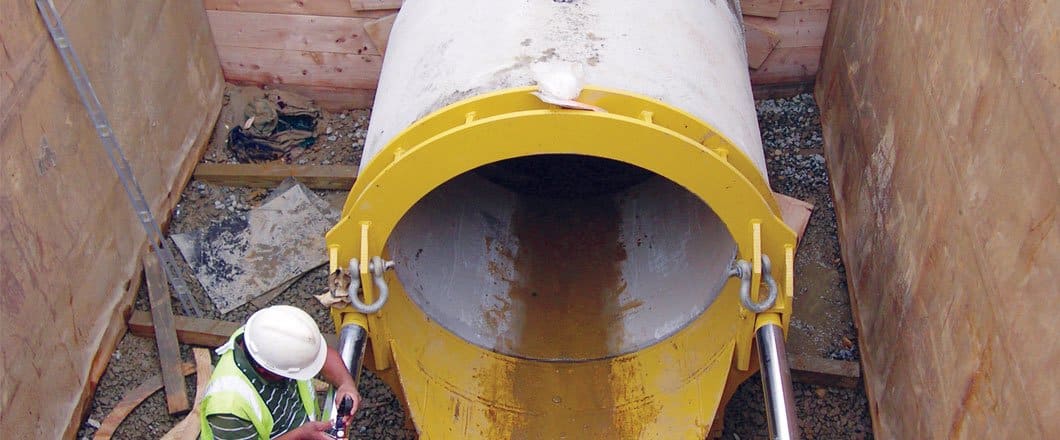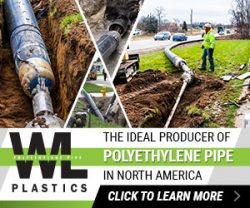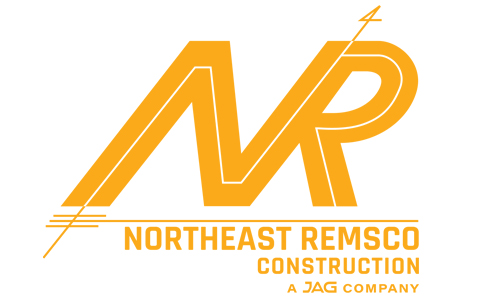
2020 Trenchless Technology Pipe Selection Guide
Pipe is pipe, right? To say or believe that clearly shows that you are uninformed — and that is a description we do not want our readers to be. So, we are here to help.
Concrete. Ductile iron. Fiberglass reinforced. HDPE. Polymer concrete. PVC. Steel. Vitrified clay. These types of pipe are routinely the product pipe of choice on today’s trenchless projects. Deciding which pipe is best suited for any given trenchless project — whether it be sewer, water, gas or fiber optic/telecom — is an important part of the project design process. How do you know which will serve your needs the best?
To help you out, Trenchless Technology contacted pipe associations and manufacturers of the eight pipes typically used in trenchless projects to showcase what their particular conduit offers. We have provided this valuable information several times in recent years, the last being in 2015. Some have changed in the five years, others have not but we are offering our valued readers an updated roundup of these pipe. As always, the information before you is only intended to give you a glimpse at the different pipe in the market. For more detailed information to see which pipe will work best for your project, please contact the manufacturer, pipe association or project engineer.
All the information presented was provided by the pipe associations or manufacturer.
CONCRETE
 Trenchless Applications:
Trenchless Applications:
Jacking and microtunneling and instances where high compressive strength is needed for pushing a pipeline into its final location.
Best Suited For:
Precast concrete buried structure units are well suited for applications where high compressive forces are needed for the process of installation, such as jacking and microtunneling. Shapes, such as circular, elliptical, arch and rectangular box sections allow for a variety of choices to accommodate physical obstructions that may limit available space.
Not Well Suited For:
Concrete pipe is not well suited for applications having high internal pressure.
How Is It Delivered:
Precast concrete pipe and boxes are delivered in precast units that are ready for installation.
How Is It Joined:
Precast concrete pipe and box units can be supplied with soil resistant, silt resistant, and leak resistant joints. For microtunneling installations gasketed joints are typically used, along with a large bearing area in the joint for jacking forces.
Available Diameters:
Circular reinforced concrete pipe is available from 12 in. to 144 in. in diameter. Elliptical and Arch shapes are available for locations with limited vertical or horizontal clearance. These shapes have sizes equivalent to a 132-in. diameter circular pipe and less. Additionally, square and rectangular shapes are available in standard dimensions up to 12 ft by 12 ft, with larger nonstandard sizes available.
Design Life:
Concrete pipe has a proven service life of more than 100 years.
Latest Development over the Last Five Years:
Advancements in the use of cementitious materials and admixtures in the production of concrete pipe continue, providing greater strength and longer durability. Additionally, manufacturing equipment and processes continue to evolve and improve. ASTM standards for jacking and microtunneling pipe are being developed.
What Is Notable about Your Pipe:
Precast concrete pipe can be supplied in a variety of sizes, shapes, and strengths. When precast concrete pipe is specified and installed, there is less anxiety about conforming to product limitations and greater confidence in performing to expectations.
Source: American Concrete Pipe Association
Web: concrete-pipe.org
DUCTILE IRON PIPE
 Trenchless Applications:
Trenchless Applications:
Horizontal directional drilling, pipe bursting, microtunneling, and pipe jacking.
Best Suited For:
Water and wastewater pipeline installations, both gravity and pressure applications, and any installations that require a robust/strong pipe.
Ill Suited For:
There really isn’t a water or wastewater pipe project where ductile iron pipe would be ill suited.
How It Is Delivered:
Normally, 18- or 20-ft lengths. The standard push-on joint can also be cut in the field if shorter lengths are needed.
How It Is Joined:
For underground service, gasketed push-on joints are normally specified. In HDD applications, a restrained joint is needed – check with pipe manufacturers for recommendations. Other proprietary compression ring gasketed joints that facilitate trenchless applications. The push-on joint is deflectable (as much as 5 degrees) to facilitate HDD applications and routing the pipeline with minimal fittings.
Available Diameters:
3-in. diameter through 64-in. diameter (3, 4, 6, 8, 10, 12, 14, 16, 18, 20, 24, 30, 36, 42, 54, 60 and 64-in. diameters)
Design Life:
Indefinite when properly designed and installed.
Applicable Standards:
- ANSI/AWWA C104/A21.4 – Cement-Mortar Lining for Ductile-Iron Pipe and Fittings
- /AWWA C105/A21.5 – Polyethylene Encasement for Ductile-Iron Pipe Systems
- ANSI/AWWA C110/A21.10 – Ductile-Iron and Gray-Iron Fittings
- ANSI/AWWA C111/A21.11 – Rubber-Gasket Joints for Ductile-Iron Pressure Pipe and Fittings
- ANSI/AWWA C115/A21.15 – Flanged Ductile-Iron Pipe with Ductile-Iron or Gray-Iron Threaded Flanges
- ANSI/AWWA C116/A21.16 – Protective Fusion Bonded Coatings for the Interior and Exterior Surfaces of Ductile-Iron and Gray Iron Fittings
- ANSI/AWWA C150/A21.50 – Thickness Design of Ductile-Iron Pipe
- ANSI/AWWA C151/A21.51 – Ductile-Iron Pipe, Centrifugally Cast
- ANSI/AWWA C153/A21.53 – Ductile-Iron Compact Fittings
- ANSI/AWWA C600 – Installation of Ductile-Iron Mains and Their Appurtenances
- ASTM A746 – Ductile Iron Gravity Sewer Pipe
- ASTM A716 – Ductile Iron Culvert Pipe
RELATED: Tech Forum – Protecting Ductile Iron Pipe
Latest Development over the Last Five Years:
DIPRA has introduced a co-extruded polyethylene encasement for corrosion control. The V-Bio enhanced polyethylene encasement is infused with a corrosion inhibitor and an anti-microbial component to provide active corrosion control. DIPRA has also published, along with Corrpro Companies, a revised Design Decision Model (DDM®) for use in mitigating aggressive environments.
What Is Notable about Your Pipe:
“Successful trenchless installations have firmly established ductile iron pipe as a viable, and in many instances superior, pipe option. The advantages of using ductile iron pipe for trenchless installations include:
- Standard pressure capabilities up to 350 psi (greater upon special request)
- Great material strength for handling pull-back, column, and external dead and live loading
- Better distribution of thrust or pulling forces around the bell and barrel
- Greater allowable pulling forces than other pipe options
- Generous allowable joint deflections
- Quick, easy joint assembly
- “Cartridge” installation option for limited easements or ROW
- Can be located from surface with commonly used locators
- Performance capabilities are not impacted by elevated temperatures
- Material strength that does not creep or decrease with time
- Pipe wall impermeable to volatile hydrocarbons, minimizing the potential of water system contamination in the present or future
- A very strong pipe able to handle residual bending stresses that could adversely affect future serviceability.
- No significant “recoil” and minimal pipe movement due to thermal expansion.
- Eliminates potential for shearing of tapped lateral outlets due to thermal expansion and contraction
With the increasing demand for water and wastewater infrastructure and a movement to reduce the social-economic impact on rate payers that is often associated with open-cut construction, trenchless installation will certainly play an increasing role. For these installations, public works personnel and contractors have the option of installing superior ductile iron pipe.”
Source: Ductile Iron Pipe Research Association
Web: dipra.com
VITRIFIED CLAY JACKING PIPE (VCP-J)

Trenchless Applications
Pilot Tube Method (PTM) of Guided Boring, microtunneling, slurry microtunneling, static pipe bursting, sliplining existing pipe and casing.
Best Suited For
Gravity flow sanitary sewers
Ill Suited For
Pressure applications
How It Is Delivered
VCP is available in a variety of stock or custom lengths, depending on diameter, jacking frame and shaft size. Common lengths are 1 and 2 m.
How It Is Joined
Low-Profile Compression Joints utilizing 316 grade stainless steel collars
Available Diameters
8 to 24 in. I.D.
Design Life:
200-plus years
Applicable Standards
ASTM C-1208, EN 295-7
Latest Developments over the Last Five Years
Guided boring/pilot-tube method techniques with VCP are achieving precision drives of more than 400 LF. ASCE/ UESI has released a Manual of Practice on the method entitled Pilot Tube and Other Guided Boring Methods (MOP No. 133; available at asce.org). VCP is currently being used as the replacement product in static pipe bursting methods resulting in a rigid, abrasion resistant, long-lasting, gravity flow conduit.
What Is Notable about Your Pipe
VCP-J is the predominant small diameter direct-jacked product pipe material due to its unmatched compressive strength (18,000 psi average), low-profile, zero-leakage joint and proven unmatched service life. Vitrified clay is a fired ceramic with material properties unaffected by age, light or chemicals. It provides unmatched durability to aggressive cleaning tools and techniques. Today’s vitrified clay jacking pipe coupled with trenchless installation methods allow municipalities to design, construct and maintain the most sustainable collection systems of this century.
Source: National Clay Pipe Institute
Web: ncpi.org
HIGH DENSITY POLYETHYLENE (HDPE)

Trenchless Applications
Horizontal directional drilling, static and pneumatic pipe bursting, Swagelining and sliplining using solid wall HDPE piping systems.
Best Suited For
Potable water services, distribution and transmission, reclaimed water, sewer (force main, gravity, storm), industrial, nuclear, power (electrical and communication) and gas. This summary will focus on HDPE solid wall for water and sewer.
// ** Advertisement ** //
Ill Suited For
Pressure applications with annual average temperature exceeding 140 F and Pressure Class exceeding 335 psi.
How It Is Delivered
HDPE pipe is produced in straight lengths up to 50 ft and coiled in diameters up to 6 in. Depending on pipe size, coiled length can exceed 1,000 ft.
RELATED: A Refresher on Electrofusion Preparation
How It Is Joined
Butt-fusion and electrofusion are the preferred methods for joining HDPE; both systems are self-restrained joints. However, HDPE can also be joined by mechanical fittings that are properly designed for HDPE pipe.
Available Diameters:
¾ in. to 65 in.
Design Life:
Properly designed, installed, inspected and operated HDPE piping systems have a minimum design life of 100 years.
Applicable Standards:
- AWWA (C901, C906, M55)
- CSA B137.1
- FM 1613
- ASTM (D2321, D2683, D2774, F585, F905, F1041, F1055, F1290,
- F1563, F1962, F2164, F2206, F2620, F3124, F3190)
- NSF (14, 61).
Latest Developments over the Last Five Years
High performance PE4710 has been implemented in U.S. and Canadian standards, manuals and software.
New documents and resources were published (or updated) as listed below:
- MAB-1 and MAB-2 on electrofusion
- MAB-3 Model Specifications
- MAB-4 on Repairs
- MAB-5 on pipe bursting
- PPIPACE for water hammer and fatigue (Software)
- PPIboreaid for horizontal directional drilling (Software)
- HDPEapp for multiple calculations (Software)
- PPI TR-4
What Is Notable About Your Pipe:
Properly designed and installed HDPE pipes and HDPE joints have the lowest failure rate, zero allowable leakage, lowest initial and life cycle costs, inherent corrosion resistance, longest design life, longest fatigue life and are the preferred material for trenchless installations. Also, due to high ductility, HDPE water piping systems had zero failures in the last five earthquakes in Japan, Chile and New Zealand.
Source: Plastics Pipe Institute Inc.
Web: plasticpipe.org/municipal_pipe
POLYMER CONCRETE

Trenchless Applications:
Microtunneling, pipe jacking, one-pass tunnel segments. Structures and shafts for tunnel construction.
Best Suited For:
For sanitary sewer or industrial sewer service where conditions require corrosion protection.
Ill Suited For:
Currently, polymer concrete pipe is not designed for or approved for pressure of potable water
applications.
How It Is Delivered:
Pipe is typically delivered in 8- or 10-ft lengths by means of truck, closed container for ocean freight or rail. For pilot tube installation methods, 1 m lengths are available.
How It Is Joined:
Standard joint for jacking installations incorporates a double spigot joint joined by a flush compression fit fiberglass or stainless steel collar. The collar mates against the gasket firmly joined to the pipe wall. The joint meets the requirements of several ASTM standards.
Available Diameters:
Polymer concrete pipe is available in diameters ranging from 8 to 144 in.
Design Life:
Polymer concrete pipe has a projected 100-year plus service life.
Applicable Standards:
ASTM D6783. Other standards including ASTM C-76 and AWWA design methods can be used.
Latest Development over the Last Five Years:
Production capacity of polymer concrete pipe and products has increased significantly in recent years. Product availability in several geographic locations will translate into freight savings for owners.
What is Notable about Polymer Concrete Pipe:
“In choosing a pipe material, owners have found that polymer concrete pipe, with its unique physical properties, combines the best attributes of the leading pipe materials- inherent corrosion resistance of FRP pipe along with the rigid properties of reinforced concrete pipe. Years back when we first introduced the reinforced polymer concrete pipe to the market we often described polymer concrete pipe as a hybrid to those unfamiliar with the product. Nowadays, everyone is much more familiar with polymer concrete and our product availability has increased significantly even in the last couple years with added production capacity in North America,” Mike Olson, Interpipe Polymer/PolymerCrete.
Source: Interpipe Polymer/PolymerCrete
Web: polymerpipe.com
POLYVINYL CHLORIDE (PVC)
Trenchless Applications
Segmental sliplining, directional drilling, close-fit pipe lining and pipe bursting
Best-Suited For
Potable water, reclaimed water, sewer force main, gravity sanitary sewer, and storm sewer pipe and fittings
Ill-Suited For
Temperature applications where fluid conveyed is consistently greater than 140 F or high-pressure applications consistently above 305 psi
How It Is Delivered
Standard lengths are 20 ft for pressure pipe and 14 or 20 ft for sewer pipe. Alternative lengths are available on a limited basis.
How It Is Joined
Horizontal directional drilling (HDD) applications utilize spline-locked gasketed couplers or joints, bell-and-spigot joints locked together with an internal gripper ring assembly, bell-and-spigot joints locked together with ring-and-pin assembly, or butt-fusion joints. Slipliner pipe applications utilize gasketed joints. Close-fit lining and pipe bursting applications utilize butt-fusion joints.
Available Diameters
Gasketed PVC pressure pipe is available is sizes from 4 to 60 in. Gasketed PVC gravity sewer pipe is available from 3 to 60 in.
Design Life Studies confirm that PVC pipe lasts in excess of 100 years.
Applicable Standards
Pressure Pipe and Fittings: ASTM D2241, AWWA C900, AWWA C907, AWWA C909, CSA B137.3, and CSA B137.3.1
Sewer Pipe and Fittings: ASTM D3034, ASTM F679, ASTM F794, ASTM F949, ASTM F1336, ASTM F1803, and CSA B182.2
Latest Developments over the Last Five Years
Standards: AWWA C900 and C905 were unified into a single standard, C900, which now includes sizes 4-in. through 60-in. The Contractor’s Installation Guide for Gasketed PVC Pipe has been recently published, providing installers and users with the most up-to-date information.
A Life Cycle Assessment (LCA) in accordance with ISO 14040 series was published showing that PVC pipe has the lowest environmental impacts and life cycle costs as well as the lowest embodied energy and carbon footprint of all pipe materials.
An ISO 14025 compliant Environmental Product Declaration (EPD) certified by NSF International was issued for PVC water and sewer pipe. The EPD transparently discloses the environmental impacts of PVC pipe.
What is Notable about your Pipe
PVC water and sewer pipe has been in service in North America for almost 70 years, with more than 2 million miles installed. According to a 2018 Utah State University report, PVC pipe has the lowest break rate of all commonly used pipe materials in the U.S. and Canada.
Source: Uni-Bell PVC Pipe Association
Web: uni-bell.org
FIBERGLASS REINFORCED PIPE

Trenchless Applications:
Pressure and gravity sliplining, microtunneling/jacking, tunnel lining casings, pipe bursting and directional drilling.
Best Suited For:
Potable water transmission, force main or gravity sewer systems and all applications where there is a corrosive carrier or external environment.
Ill Suited For:
Really not a water or wastewater project in which fiberglass reinforced pipe would be ill suited.
RELATED: 2019 Project of the Year Rehabilitation Winner: Joint Outfall “B” Unit 1A Phase 1
How It Is Delivered:
The typical delivered length is 20 ft; however, both short sections (e.g. 5 ft and 10 ft) and longer lengths of up to 40 ft are available to minimize the number of joints.
How It Is Joined:
Unless otherwise specified, the pipe shall be field connected with fiberglass sleeve couplings that utilize elastomeric sealing gaskets to maintain joint water tightness. The joints must meet the performance requirements of ASTM D4161. Tie-ins, when needed, may utilize gasket-sealed mechanical couplings.
Available Diameters:
The pipe is available from 18 to 158 in. in diameter.
Design Life:
In excess of 100 years.
Applicable Standards:
AWWA C950 for Fiberglass pressure pipe and ASTM D3754 for Fiberglass Sewer and Industrial Pressure pipe. ASTM D3262 for gravity systems. ASTM D4161coupling joints. ASTM D2412 External Loading Characteristics by Parallel-Plate loading. Fiberglass pipe can be utilized in a wide range of service conditions including extreme cold, which does not affect the material and operating temperatures up to 180 F, with pressures up to 250 psi. Each pipe is designed for soil burden, external water pressure and live loading conditions. The pipe is easily repairable and modify in the field should conditions warrant. Hydraulic analysis shows superb flow characteristics, Manning’s of n=0.009 and Hazen Williams of C=155. In addition, the pipe surface is extremely abrasion resistant.
Latest Development over the Last Five Years:
The United States increased application of sliplining and pipe jacking that enables public utilities to maintain their sewage system operation requires a corrosion resistant pipe that can accomplish high push-loading. In addition, there is an increased application of microtunneling, pipe bursting and directional drilling where fiberglass pipe and manway manufacturers are providing a corrosion resistant alternative to traditional pipe materials. The Fiberglass Tank & Pipe Institute represents the following manufacturers of pipe and manways listed alphabetically: Containment Solutions Inc., NOV Fiber Glass Systems, Hobas Pipe USA and L.F.Mfg. The Institute Web site
fiberglasstankandpipe.com maintains a direct link to these manufacturers
Source: Fiberglass Tank & Pipe Institute
Web: fiberglasstankandpipe.com
Steel Pipe

Trenchless Applications:
Directional drilling, jack-and-bore and pipe ramming
Best Suited For:
Water and wastewater transmission, gas and oil transmission, water well casing, pile driving and caisson sleeves.
Ill Suited For:
Chemical or corrosive service without internal or external protective coatings.
How It Is Delivered:
Steel pipe is generally supplied in laying lengths 20 to 60 ft. Some diameters of pipe can be manufactured in lengths up to 120 ft or longer without a girth mid-weld.
How It Is Joined:
The most common method of assembling steel pipe is by field welding or bell and spigot joints with rubber o-ring gaskets, other methods include threading-and-coupling or compression fittings.
Available Diameters:
Steel pipe is available in diameters 4 in. and larger with virtually an unlimited choice of fitting and special fabrications possible.
Design Life:
The design life of steel pipe is based on the mechanical strength of steel which is fully elastic and not time dependent. If properly installed, with the appropriate lining and coating, steel pipe with the addition of electrical bonding and cathodic protection (if required) can last indefinitely
Applicable Standards:
AWWA standards include C200 and Manual of Standard Practice for the Design and Installation of Steel Water Pipe M11, ASTM standards for steel pipe include A53, A106 A139, A252. The most common API standard for steel pipe is API 5L
What Is Notable about Your Pipe:
The performance resume for steel pipe dates back to the early 1850s. This experience in pressure applications for water, gas and petroleum fluids cannot be matched by any other pipe material, particularly those made from plastic materials that are visco-elastic, where the material strengths erodes overtime. Steel pipe, with its simple, straight-forward design procedure and pragmatic installation requirements, is finding its way into project specifications once dominated by pipes of composite construction. STI/SPFA member companies are certified for the SPFA Certification program by Lloyd’s Register Quality Assurance. This provides owners and engineers with assurance that their steel pipe is manufactured in strict accordance with applicable AWWA, ASTM and other standards and industry accepted practices.
Source: Steel Tank Institute/Steel Plate Fabricators Association (STI/SPFA)
Web: steeltank.com
Sharon M. Bueno is managing editor of Trenchless Technology.








